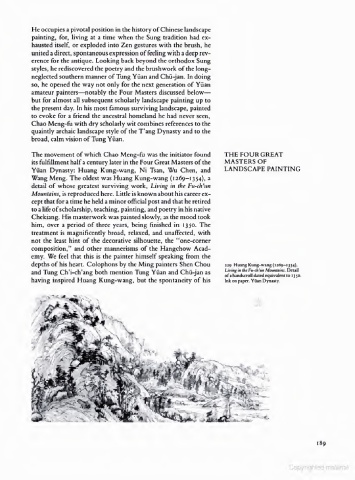Page 209 - The Arts of China, By Michael Sullivan Good Book
P. 209
—
He occupies a pivotal position in the history of Chinese landscape
painting, for, living at a time when the Sung tradition had ex-
hausted itself, or exploded into Zen gestures with the brush, he
united a direct, spontaneous expression of feeling with a deep rev-
erence for the antique. Looking back beyond the orthodox Sung
styles, he rediscovered the poetry and the brushwork of the long-
neglected southern manner of Tung Yuan and Chu-jan. In doing
so, he opened the way not only for the next generation of Yuan
amateur painters—notably the Four Masters discussed below
but for almost all subsequent scholarly landscape painting up to
the present day. In his most famous surviving landscape, painted
to evoke for a friend the ancestral homeland he had never seen,
Chao Meng-fu with dry scholarly wit combines references to the
quaintly archaic landscape style of the T'ang Dynasty and to the
broad, calm vision of Tung Yuan.
The movement of which Chao Meng-fu was the initiator found THE FOUR GREAT
its fulfillment half a century later in the Four Great Masters of the MASTERS OF
Yuan Dynasty: Huang Kung-wang, Ni Tsan, Wu Chen, and LANDSCAPE PAINTING
Wang Meng. The oldest was Huang Kung-wang (1269-13 54), a
detail of whose greatest surviving work, Living in the Fu-ch'un
Mountains, is reproduced here. Little is known about his career ex-
cept that for a time he held a minor official post and that he retired
to a life of scholarship, teaching, painting, and poetry in his native
Chekiang. His masterwork was painted slowly, as the mood took
him, over a period of three years, being finished in 1350. The
treatment is magnificently broad, relaxed, and unaffected, with
not the least hint of the decorative silhouette, the "one-corner
composition," and other mannerisms of the Hangchow Acad-
emy. We feel that this is the painter himself speaking from the
depths of his heart. Colophons by the Ming painters Shen Chou 220 Huang Kung-wang (1269-1354),
Living in tht Fu-th 'un Mountains. Demi
and Tung Ch'i-ch'ang both mention Tung Yuan and Chii-jan as
of a handicroU dated equivalent to 1 3 50.
having inspired Huang Kung-wang, but the spontaneity of his Ink on paper. Yuan Dynasty.
I89

